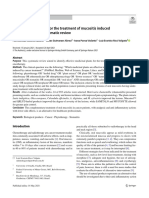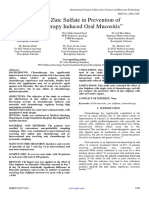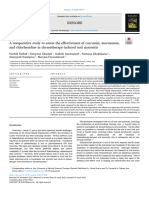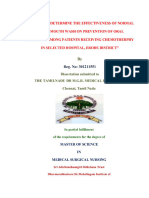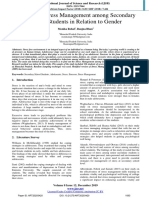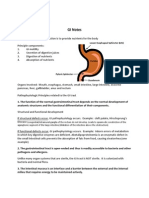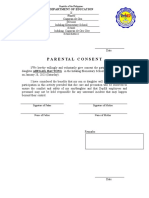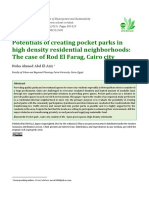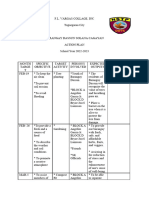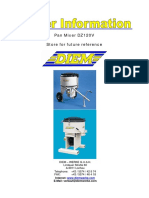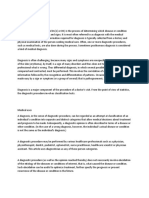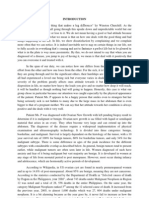Effectiveness of Turmeric Oral Rinse Versus Saline Oral Rinse On Oral Mucositis Among Patients Receiving Chemotherapy
Effectiveness of Turmeric Oral Rinse Versus Saline Oral Rinse On Oral Mucositis Among Patients Receiving Chemotherapy
Volume 9, Issue 6, June – 2024 International Journal of Innovative Science and Research Technology
ISSN No:-2456-2165 https://doi.org/10.38124/ijisrt/IJISRT24JUN1914
Effectiveness of Turmeric Oral Rinse Versus Saline
Oral Rinse on Oral Mucositis among Patients
Receiving Chemotherapy
Gayathri S.1; Dr. P. Padmavathi2; Chandramathi K.3
1
M.Sc. Nursing II Year; 2Principal, 3Professor
1,2,3
Dhanvantri College of Nursing, Namakkal, Tamil Nadu
Abstract:- turmeric oral rinse is greater powerful than saline oral
rinse on oral mucositis among patient receiving
Background: chemotherapy. Chi rectangular test confirmed handiest
Oral mucositis is the commonplace problem of mass length of cancer (p>0.05) in both the class up and the
cancers’ chemotherapy. It begins five-10 days after the boxcar variable haven't any good-sized association with
initiation of chemotherapy and lasts 7-14 days. the submit-check score of stage of oral mucositis in both
Chemotherapy precipitated oral mucositis reasons the intervention class I and II. Conclusion: The findings
mucosal lining of the oral to atrophy and break down, found out that imply publish check scores was 34.24±1.28
forming ulcers. The take a look at is to evaluate the in intervention class I, in intervention class II publish-
effectiveness of turmeric oral rinse and saline oral rinse check rating changed into 24.07± 1.27 revealing the
on patents with chemotherapy precipitated oral mucositis distinction of 36%. It depicts that the turmeric oral rinse
in determined on sanatorium. became greater powerful than saline m oral outh rinse in
lowering the extent of oral mucositis among patient taking
Design: chemotherapy.
Casual research design was selected for the study;
inclusion criteria were selected by non-probability Keyword:- Effectiveness, Turmeric Oral Rinse, Saline Oral
sampling technique. Rinse, Oral Mucositis.
Selection criteria: the inclusion criteria included Patients
under chemo therapy with the age class above age class of I. INTRODUCTION
20-65 years and both the gender.
"Cancer can touch you, but not your soul; neither your
Methods: thoughts, nor your heart."- Vikrmn
A study was conducted patients with oral mucositis
among patients receiving chemotherapy. The assessment Maximum cancers are due to specific DNA harm.
tools were used national cancer institute oral mucositis numerous common mechanisms that cause DNA damage
grading scale. cause particular malignant issues: First, proto-oncogenes may
be activated with the resource of translocations, 2d; proto-
Results: oncogenes may be activated by way of thing mutations.
From the findings of the have a look at, it can be Proteins from those mutated genes are constitutively lively in
concluded that the overall vicinity smart comparison preference to honest to the second one messengers of periodic
among intervention class I and II imply percent score for extracellular indicators. 0.33, mutations that inactivate a gene
pretest became 88%, revealing the difference of 59% in can bring about tumors if the gene product typically limits
intervention class 47 % for numerical pain assessment cellular proliferation. Dodd MJ et al, (2022)
scale. tremendously full-size variations had been
discovered in experimental organization I. but, in The starting place of the word cancer is attributed to the
treatment group II pretest rating become 25% while in Greek health practitioner Hippocrates (460-370 BC), who is
submit-test it was sixty-one% revealing the difference of considered the "father of medication". In Greek, these phrases
36%. It depicts that the turmeric oral rinse was greater talk to a crab, most possibly relating to this disease, as the
effective than saline oral rinse in lowering the extent of finger-like, increasing growths of the most cancers resembled
oral mucositis among affected person receiving chemo the shape of a crab. Dr. Ali Raad Abdul Azeez et. Al, (2019)
remedy. Paired t check score become 14.43 and 8.52 in
intervention class I and II, when as compared to desk Maximum cancers are one of the main reasons of lack
value (2.15) each are elevated. This suggests that there has of existence worldwide. A predicted eighty-four million
been an effectiveness between submit test score of degree humans died from maximum cancers amongst 2005 and 2015
of oral mucositis among affected person receiving chemo without intervention. Low- and middle-profits nations are
therapy in intervention class I and II. paired and unpaired more stricken by maximum cancers than superior countries.
“t” check confirmed, there was a huge effectiveness of Addressing the growing burden of most cancers global and
IJISRT24JUN1914 www.ijisrt.com 3139
Volume 9, Issue 6, June – 2024 International Journal of Innovative Science and Research Technology
ISSN No:-2456-2165 https://doi.org/10.38124/ijisrt/IJISRT24JUN1914
powerful control measures to restrict the threat are critical. 250,000 instances (an envisioned 4 percent of most cancers
Neethu Chandran (2019) occurrence) and sixty-three,500 deaths
The most styles of cancer are carcinoma, sarcoma, A. Objectives
cancer, lymphoma, and leukemia. Carcinomas, the most
normally recognized cancers originate within the pores and The Objectives of the Study Are
skin, lungs, breasts, head and neck, pancreas, and remarkable
organs and glands. Head and neck most cancers refers to a To assess the level of oral mucositis among patient
hard and fast of biologically comparable cancers that start receiving chemotherapy drug before and after turmeric
within the lip, oral cavity (oral), nasal hollow space (indoors mouth wash in experimental group I.
nose), paranasal sinuses, pharynx and larynx. There are 0. 5 To assess the level of oral mucositis among patient
million new instances an international. R.L Foote et al (2019) receiving chemotherapy drug before and after saline
mouth wash in experimental group II.
Steady with the country wide cancer Institute, maximum To compare the effectiveness of turmeric mouth wash and
cancers is a group of sicknesses regarding unusual cellular Saline mouth wash on oral mucositis among patient
increase with the capacity to invade or spread to other receiving chemotherapy in experimental group I and
components of the frame. these contrast with benign tumors II.
that don't unfold to different additives of the frame. extra than To find out the association between the post test scores of
a hundred types of most cancers have an effect on humans. oral mucositis among patient receiving chemotherapy in
most cancers are an ailment method that starts off evolved at experimental group I and II and their selected boxcar
the same time as a mobile is transformed via a genetic variables
mutation of the cell's DNA that office work a clone and ends
in metastasis. J. Sorensen, (2017) B. Hypothesis
Most cancers is a collection of more than 200 illnesses The following Hypothesis were Formulated for the Study
characterized by means of out of control and unregulated to be Tested at 0.05 Level ofSignificance
mobile growth. it's miles a main fitness hassle that occurs in
all and sundry of all ethnicities. The most often diagnosed H1 There is a significant level of oral mucositis among
cancers worldwide had been lung (1.8 million, thirteen% of patient receiving chemotherapy drug before and after
the entire) and breast (1.4 million, nine.7%). The maximum turmeric mouth wash and saline mouth wash in
common reasons of dying had been lung (1.6 million, 19.4% experimental group I and experimental group II.
of the full), liver (0.8 million, 9.1%) and stomach (0.7 million,
H2 There is a significant effectiveness of turmeric
8.8%) cancers. Cheng, k. F., (2017) mouth wash and Saline mouth wash on oral mucositis
among patient receiving chemotherapy in experimental
Cancer is the second leading cause of death in the world.
group I and II.
In 2006, 564830 died due to cancer which is more than 1500
H3 There is a significant association between the post
people per day. The five-year survival after cancer diagnosis
test scores of oral mucositis among patient receiving
is 65%. In 2007, 37% premature cancer deaths occur among
chemotherapy in experimental group I and II and their
the age group of 25-64 years. Incidence of Gastro Intestinal
selected boxcar variables.
GI cancer is high over 40-85 years. The ratio of cancer among
male to female is 1.67:1.0. In 2011, more than 1.5 million
II. LITERATURE REVIEW
people around the world were diagnosed as having cancer.
Among them, more than 570,000 died. Breast & GI cancer,
Paiar et al., (2020) Mucositis motives 9 to 19% of
especially colorectal cancer is the leading cause of death.
chemotherapy and radiotherapy interruptions [7]. This has
according to the latest global most cancers report from the
a examine emerge as supported thru Trotti a Bellm l. a. et al,
arena health corporation (WHO), extra girls in India are being
who finished a take a look at to decide the prevalence of
newly diagnosed with most cancers annually. As in
mucositis and correlation results in patients receiving
opposition to four. Seventy-seven lakh men, five.37 lakh girls
radiotherapy (RT) for head and neck most cancers through a
had been identified with cancer in India 2012. these kinds of
systematic assessment. normal with the have a look
give an explanation for the significance of cancer and requires
at protocol, databases have been looked
its spark off treatment. Basheer Mohamed Abdalrahman
or randomized medical trials (English excellent, 1996-1999)
(2014).
of head and neck maximum cancers sufferers receiving RT, a
whole of 16% with or without chemotherapy,
Head and neck tumours are the 6th maximum
that counselled one or extra outcomes of hobby.
commonplace most cancers worldwide. It accounts for more
than 550,000 instances and 380,000 deaths yearly." in the
Setiawan, (2018) each day chlorhexidine oral rinse is
United States, head and neck cancer debts for 3 percentage of
frequently advocated for the prevention of chemotherapy-
malignancies, with about 63,000 people developing head and
brought on oral mucositis. Povidone-iodine, NaCl 0. nine %,
neck cancer every year and thirteen,000 demise from the
aqueous sodium salt and chamomile oral rinse also are
disease eighty-three. In Europe, in 2012, there had been about
recommended. but, the effectiveness of these oral rinse is
IJISRT24JUN1914 www.ijisrt.com 3140
Volume 9, Issue 6, June – 2024 International Journal of Innovative Science and Research Technology
ISSN No:-2456-2165 https://doi.org/10.38124/ijisrt/IJISRT24JUN1914
unsure. therefore, we finished a scientific take a look at to potential to continue nourishment, Flavors and Self-care
evaluate the effectiveness of oral rinse in stop and alleviating assessment, each complement are having 3 options and score
chemotherapy-caused oral mucositis. based totally mostly on between 1 to 3. information series way: Permission from the
look at quality, 3 of the five randomized managed trials have involved authority; preceding to collection of records,
been protected within the meta-evaluation. The effects permission modified into obtained from handling Director of
confirmed no beneficial results of chlorhexidine conversely cancer area of expertise Centre. length of records collection:
to bacteriostatic water or NaCl 0. nine %. patients charge of The data grow to be accumulated from 01-08-2023 to 26 -09-
poor issue results of chlorhexidine, which includes teeth 2023. The investigator gathered the facts from each
discoloration and flavour modifications in two of the 5 intervention class I and II. Pretest: Pretest changed into
chlorhexidine research. In a single randomized managed trial, carried out earlier than beginning 2d cycle of chemotherapy
the severity of oral mucositis ends up shown to be reduced via remedy thru the usage of countrywide most cancers Institute-
using 30% with the use of povidone-iodine oral rinse in commonplace toxicity criteria- Oral Mucositis grading scale.
assessment to sterile water. these results do now not useful Turmeric oral rinse (interventional group I) oral rinse answer
resource using chlorhexidine oral rinse to prevent oral prepared by means of blending five grams of turmeric powder
mucositis. with 50 ml of water. each time a 50 ml of freshly prepared
turmeric oral rinse answer became administrated 2 instances
Bensinger et al., (2018) primarily based totally a day for four weeks. Saline oral rinse (interventional group
on severity, OM is assessed as tolerable mucositis (grade 1 II) Medicated 50 ml of saline oral rinse solution changed into
and a couple of mucositis) and intolerable mucositis administrated 2 instances an afternoon for 4 weeks. post-test:
(grade 3 and better) (Khanal et al., 2010). In publish take a look at turned into carried out after 29 days of
HNC present way radiotherapy, tolerable mucositis starts off chemotherapy remedy with the aid of the usage of
evolved off advanced in all sufferers and countrywide most cancers Institute-commonplace toxicity -
is viable, intolerable mucositis requires powerful ache contr Oral Mucositis grading scale. Post evaluation: check the
ol, gastrostomy tube, IV line for nutritional supplementation amount of oral mucositis among patient receiving
(Elting et al., 2008). this could additionally result chemotherapy drug before and after turmeric oral rinse in
in discounts in radiotherapy and dose delays, even preventing interventional institution I was analysed via the usage of
planned radiotherapy, consequently complicating the relative frequency distribution. examine the extent of oral
underlying most cancers treatment. mucositis among patient receiving chemotherapy drug earlier
than and after saline oral rinse in class II become analysed by
III. METHODOLOGY means of the use of frequency and percent. evaluate the
effectiveness of turmeric oral wash and Saline oral rinse on
design: The research design selected for the existing oral mucositis amongst patient receiving chemotherapy in
look at became a real interventional research layout turned interventional organization I and II became analysed by using
into selected to evaluate the success of turmeric oral rinse and mean, trendy deviation, mean percentage, paired ‘t’ check
Saline oral rinse on oral mucositis among affected person and unpaired ‘take a look at. find out the affiliation among the
receiving chemotherapy. setting: the prevailing observes post-test rankings of oral mucositis amongst patient receiving
changed into performed at most cancers’ distinctiveness chemotherapy in interventional institution I and II and their
centre. it's far located 30 Kms far from Dhanvantri university selected boxcar variables was analysed via the usage of Chi-
of Nursing. it's far a hundred and fifty bedded private clinic rectangular check.
and has incredibly prepared techniques. An approximately 12
-15 sufferers are receiving chemotherapy treatment. sample:
The samples selected for the present have a look at have been
the sufferers receiving chemotherapy remedy in selected
hospital who have been inclined to take part and gift
throughout the length of statistics collection. sample size: the
overall pattern size changed into 30 cancer sufferers, out of
which 15 patients have been interventional group I and 15
patients were interventional corporation II. Sampling
technique: non probability sampling tactics. improvement of
tool: phase A It consists of boxcar characteristics of patients
receiving chemotherapy, i.e., Age, each sex, cancer stages,
own family history of cancer, period of contamination,
prevalence of taking oral hygiene, life fashion conduct.
section B countrywide most cancers Institute-commonplace
toxicity standards- Oral Mucositis grading scale. it's miles a
standardized device. It includes 13 items such as voice,
consume, mucosa, saliva, Tongue, gums, Lips, Teeth,
IJISRT24JUN1914 www.ijisrt.com 3141
Volume 9, Issue 6, June – 2024 International Journal of Innovative Science and Research Technology
ISSN No:-2456-2165 https://doi.org/10.38124/ijisrt/IJISRT24JUN1914
IV. RESULTS
Table 1: Relative Frequency Distribution of Interventional Class I and II of Patients Receiving Chemotherapy
According to their Boxcar Variables (N1= 15, N2=15)
S. Intervention Class I Intervention Class II
No Boxcar Variables (N1) (%) (N2) (%)
1. Age in years
20-30 1 7 3 20
31-40 5 33 3 20
41-50 5 33 4 27
Above 65 4 27 5 33
2 Gender
Male 8 53 10 67
Female 7 47 5 33
3. Cancer Stages
Cervical cancer 3 20 3 20
Breast cancer 1 07 1 07
Lung cancer 3 20 2 13
Oral cancer 8 53 9 60
4. Cancer Family history
Yes 6 40 5 27
No 9 60 11 73
5. Frequency of taking oral hygiene
1 time 9 60 10 67
2 times 6 40 5 33
6. Cancer Duration
Less than 6 months 1 07 0 0
6 months – 1 year. 8 53 11 73
1 – 2 yrs 6 40 4 27
Above 2 years 0 0 0 0
7 Manner of living
Smoking 2 13 1 07
Alcohol 4 27 2 13
Chewing items 2 13 2 13
Others 7 47 10 67
Table 2: Relative Frequency Distribution of the Interventional Class I Pre Test and Post Test Scores of Levels of oral Mucositis
among Patient Receiving Chemotherapy (N1=15)
Intervention Class I
Mucositis Level Fore Test Post Test
(N) (%) (N) (%)
No mucositis 0 0 12 80
Mild 0 0 3 20
Moderate 9 60 0 0
Severe 6 40 0 0
Table 3: Relative Frequency Distribution of the Interventional Class II Pre Test and Post Test Scores of Levels of Oral Mucositis
among Patient Receiving Chemotherapy. (N2=15)
Intervention class II
Mucositis Level Fore Test Post Test
(N) (%) (N) (%)
No mucositis 0 0 8 53
Mild 3 20 7 47
Moderate 10 67 0 0
Severe 2 13 0 0
IJISRT24JUN1914 www.ijisrt.com 3142
Volume 9, Issue 6, June – 2024 International Journal of Innovative Science and Research Technology
ISSN No:-2456-2165 https://doi.org/10.38124/ijisrt/IJISRT24JUN1914
Table 4: Relative Frequency Distribution of the Interventional Class I and II Post Test Scores of Levels of Oral
Mucositis among Patient Receiving Chemotherapy. (N1=15) (N2=15)
Post Test Scores
Mucositis Level Intervention Class I Intervention Class II
(N) (%) (N) (%)
No mucositis 12 80 8 53
Mild 3 20 7 47
Moderate 0 0 0 0
Severe 0 0 0 0
Table 5: Comparison of Mean, Standard Deviation, and Mean Percentage of Level of Oral Mucositis among
Interventional Class I and II Pre and Post Test Scores
Patient receiving Max Fore test Post test Difference in
chemotherapy scores Mean SD Mean % Mean SD Mean % mean %
Intervention class I 39 11.23 1.24 29 34.24 1.28 88 59
Intervention class II 39 9.83 1.33 25 24.07 1.27 61 36
Table 6: Paired ‘t’ Test Value of Fore Test and Post Test Scores of Oral Mucositis in Interventional Class I and II
Patient Receiving Chemotherapy Paired ‘t’ Value Table Value Level of significant (P)
Intervention class I 14.43 2.15 P < 0.05 significant
Intervention class II 8.52 2.15 P < 0.05 significant
Df =14 Table value=2.15 P<0.05 significant
Table 7: Unpaired ‘t’ Test Value of Post Test Scores of Oral Mucositis in Interventional Class I and II
Patients taking chemotherapy Unpaired ‘t’ value Table value Level of significant (P)
Level of oral mucositis 7.42 2.05 P<0.05 Significant
Df=28 Table value=2.05 P<0.05 significant
Table 8: Chi-Square Value of Association Between Intervention Class I Post Test Scores with their Boxcar Variables
Boxcar variables DF 2 Table value Level of significance
Age 1 0.71 3.84 P > 0.05 NS
Gender 1 1.99 3.84 P>0.05 NS
Cancer stages 2 2.51 5.89 P>0.05 NS
Cancer Family history 1 2.82 3.84 P>0.05 NS
Frequency of taking oral hygiene 1 1.46 3.84 P>0.05 NS
Cancer Duration 2 6.51 5.89 P<0.05 significant
Manner of living 1 1.45 3.84 P>0.05 NS
Table 9: Chi-Square Value of Association between Interventional Class II Post Test Scores with their Boxcar Variables
Boxcar Variables DF 2 Table Value Level of Significance
Age 1 0.80 3.84 P > 0.05 NS
Gender 2 0.45 5.89 P>0.05 NS
Cancer Stages 1 0.02 3.84 P>0.05 NS
Cancer Family history 1 0.77 3.84 P>0.05 NS
Frequency of taking oral hygiene 1 2.02 3.84 P>0.05 NS
Cancer Duration 1 1.87 3.84 P<0.05 Significant
Manner of living 2 6.49 5.89 P>0.05 NS
V. DISCUSSION level of oral mucositis in sufferers treated with chemotherapy
(table 2).
Frequency and percent distribution of no mucositis
degree in Interventional class I before test and after take a The relative frequency distribution of mucositis stage in
look at amongst sufferers dealt with with chemotherapy Intervention organization II before take a look at and after test
suggests that most sufferers (60%) had moderate mucositis amongst chemotherapy sufferers indicates that maximum
before check and 40% had excessive mucositis, even as in sufferers before check (sixty-seven%) had mild mucositis and
post-test 80 percent of patients had none mucositis. mucositis 20% had moderate mucositis, whilst in post-test fifty-three%
and 20% of them had mild mucositis in Interventional class I. of them did now not have mucositis and forty-seven% of
Turmeric oral rinse appeared to be effective in reducing the sufferers had mild mucositis in Interventional class II. Saline
IJISRT24JUN1914 www.ijisrt.com 3143
Volume 9, Issue 6, June – 2024 International Journal of Innovative Science and Research Technology
ISSN No:-2456-2165 https://doi.org/10.38124/ijisrt/IJISRT24JUN1914
oral rinse seemed to be effective in decreasing the level of observed in mean rating values had been merely coincidental
oral mucositis in patients dealt with chemotherapy (Table 3). and no longer real differences. Chi-square became calculated
to decide the affiliation among the posttest rankings of the
The frequency and percent distribution of the level of experimental organization I patients handled with
mucositis in Intervention organization I and II after the test chemotherapy and their boxcar variables (age, gender, most
amongst patients treated with chemotherapy indicates that in cancers degrees, own family records of cancer, frequency of
Interventional class I, the majority (eighty%) of sufferers had oral hygiene use, period of most cancers, and manner of living
no mucositis and 20% had slight mucositis, while in conduct). It indicates that a sizable association (p<0.05) was
intervention class II, the general public (fifty-three %) of found only in the duration of cancer, while no significant
them had no mucositis and 47% of sufferers had slight association (p>0.05) was determined between the put up-
mucositis. Turmeric oral rinse appeared to be more effective check rankings of the interventional class I in comparison to
than saline oral rinse in decreasing degrees of oral mucositis other boxcar variables together with age, gender, sorts of
in chemotherapy patients. Evaluate the effectiveness of most cancers, family records of most cancers, frequency of
turmeric oral rinse and Saline oral rinse on oral mucositis oral hygiene and manner of living. for that reason, the
amongst patient receiving chemotherapy in Interventional variations determined in imply rating values had been merely
class I and II. The effectiveness of turmeric oral rinse and coincidental and no longer actual variations. (Table 8)
Saline oral rinse become tested with the aid of the usage of
general deviation, mean percent, paired ‘t’ test and unpaired Chi-square was calculated to determine the affiliation
‘t’ check (Table 4)the general mean rating for the pretest between posttest ratings of Interventional class II patients
suggest score turned into eleven.23 ± 1.24, which is 29%, treated with chemotherapy with their boxcar variables (age,
even as within the posttest it become 34.24 ± 1.28, which is gender, most cancers tiers, family history of cancer,
88%, revealing a distinction of 59% in the Intervention class frequency of oral hygiene use, period of most cancers,
I. however, in Intervention class II, the pre-check score manner of living. It shows that a considerable affiliation
became 9.83 ± 1.33, that's 25%, whilst in the put up-check, it (p<0.05) was found only in the duration of cancer, while no
became 24.07 ± 1.27, which is sixty one%, revealing a significant association (p>0.05) turned into found among the
difference of 36%. It indicates that turmeric oral rinse was publish-take a look at rankings of interventional class II in
more effective than saline oral rinse in decreasing the level of comparison to different boxcar variables including age,
oral mucositis in chemotherapy sufferers (Table 5) Paired ‘t’ gender, kinds of most cancers, own family records of most
test become calculated to investigate the effectiveness cancers, frequency of oral hygiene and manner of living. thus,
between pre and submit test ratings of Interventional class I the variations found in suggest score values have been merely
and II on degree of oral mucositis among affected person coincidental and not actual variations. (Table 9)
receiving chemotherapy. The paired ‘t’ takes a look at value
turned into 14. forty-three and 8.52 in Interventional class I VI. CONCLUSION
and II, while in comparison to table value (2.15) each are
high. This shows that there was a sizeable effectiveness The findings showed that the mean post-test rating of
between publish test rankings of degrees of oral mucositis oral mucositis levels in cancer sufferers in Interventional
amongst sufferers receiving chemotherapy in the class I used to be 34.24±1.28, whilst in Interventional class II
Interventional class I and II, (Table 6) the post-test imply rating turned into 24.07±1.27. It shows
that turmeric oral rinse is more powerful than saline oral rinse
Unpaired ‘t’ takes a look at become calculated to in patients receiving chemotherapy. Paired "t" test and
research the effectiveness between Intervention class I and II unpaired "t" check confirmed that in patients receiving
publish test ratings on stage of oral mucositis amongst chemotherapy, turmeric oral rinse turned into greater
patients taking chemotherapy. The unpaired ‘t’ takes a look effective than saline oral rinse for oral mucositis. Chi-square
at price changed into 7. forty-two, when compared to table test showed best the length of most cancers in each class and
cost (2.05, p<0.05), it's far excessive. evidently turmeric oral other boxcar variables have no sizeable association with the
rinse was more powerful than saline oral rinse in decreasing put up-check rating of oral mucositis degree in interventional
degree of oral mucositis amongst sufferers receiving class I and II.
chemotherapy (Table 7)
REFERENCES
Chi-square turned into calculated to determine the
affiliation among the posttest scores of the intervention class [1]. Adrianne Dill Linton, (2007). Introduction to Medical
I sufferers dealt with chemotherapy and their boxcar variables Surgical Nursing (4 Eds). Philadelphia: Elsevier
(age, sex, most cancers degrees, family history of cancer, Science Limited.
frequency of oral hygiene use, duration of cancer, and manner [2]. Alligard, M R (2002), “Nursing Theorists and their
of living conduct). It suggests that a significant affiliation Work”, (5 Eds.,) Mosby company, Philadelphia
(p<0.05) was found only in the duration of cancer, while no [3]. Basavanthappa.B. T, (2003). Medical Surgical
significant association (p>zero.05) was discovered among the Nursing (1 Eds). New Delhi: Jaypee Brothers Medical
post-test ratings of the Interventional class I as compared to Publishers
different boxcar variables consisting of age, gender, kinds of [4]. Basavanthappa. (2007). Nursing Research, (2 Eds).
most cancers, circle of relative’s records of cancer, frequency New Delhi: Jaypee Brothers Medical Publishers (P)
of oral hygiene and manner of living. hence, the differences Ltd.
IJISRT24JUN1914 www.ijisrt.com 3144
Volume 9, Issue 6, June – 2024 International Journal of Innovative Science and Research Technology
ISSN No:-2456-2165 https://doi.org/10.38124/ijisrt/IJISRT24JUN1914
[5]. Basavanthappa, B.T. (2009). Nursing Theories, (2
Eds), New Delhi. Jaypee Brothers’ publishers private
limited.
[6]. 6.Beverely Witter Du Gas. (2006). Introduction to
patient care A comprehensive approach to nursing, (4
Eds). Philadelphia: Saunders an Imprint of Elsevier
publishers.
[7]. BraunWald,E.(2001). Harrison’s Principles of
Internal Medicine, (15 Eds) Vol.-1, New York:
McGraw-Hill Medical Publishing Division.
[8]. Brenda G. Bae, Suzanne C. Smeltzer, (2004). Brunner
&Siddharth’s Textbook of Medical Surgical Nursing
(10 Eds). Philadelphia:
[9]. Lippincott Raven Publishers Denise Polit, Cheryl
Tatano Beck. (2006). Nursing Research Principles
and Methods, (7 Eds.,), New Delhi: Published by
Wolters Kluwer Health (India)
[10]. Denise Polit, Cheryl Tatano Beck. (2006). Nursing
Research Principles and Methods, (7 Eds.,), New
Delhi: Published by Wolters Kluwer Health (India)
[11]. Dirksenl Heilkemper. Lewis, (2004). Medical
Surgical Nursing (6Eds). St. Louis: Mosby Publishers
[12]. Elhart & firsich. (1994). Scientific Principles in
Nursing, (8 Eds) London: C.V. Mosby. Mosby.
Mosby Publications.
[13]. Joyce M Black, (2005). Medical surgical nursing, vol
II, (7EdS). New Delhi; Elsevier (p) ltd.
[14]. Julia.B (1998) “Nursing Theories, the Base for
Professional Nursing Practice”, (3 Eds). California,
Prentice hallPvt. Ltd.
IJISRT24JUN1914 www.ijisrt.com 3145
You might also like
- Surviving Cancer, COVID-19, and Disease: The Repurposed Drug RevolutionFrom EverandSurviving Cancer, COVID-19, and Disease: The Repurposed Drug RevolutionNo ratings yet
- AACR 2022 Proceedings: Part A Online-Only and April 10From EverandAACR 2022 Proceedings: Part A Online-Only and April 10No ratings yet
- Pharmacoepidemiology, Pharmacoeconomics,PharmacovigilanceFrom EverandPharmacoepidemiology, Pharmacoeconomics,Pharmacovigilance3/5 (1)
- PH Responsive Tumor Targeted Drug Delivery: Advancing Precision in Cancer Therapy Through NanomedicineFrom EverandPH Responsive Tumor Targeted Drug Delivery: Advancing Precision in Cancer Therapy Through NanomedicineNo ratings yet
- Understanding Multiple Myeloma: Recent Findings and Laboratory Investigation Updates for Biomedical Scientists: Continuing Professional Development in Pathology For Medical Laboratory ProfessionalsFrom EverandUnderstanding Multiple Myeloma: Recent Findings and Laboratory Investigation Updates for Biomedical Scientists: Continuing Professional Development in Pathology For Medical Laboratory ProfessionalsNo ratings yet
- Optimizing Advanced Therapies in Ulcerative Colitis: Is Your Practice Up to Date? A Focus on Clinical Evidence and Guideline RecommendationsFrom EverandOptimizing Advanced Therapies in Ulcerative Colitis: Is Your Practice Up to Date? A Focus on Clinical Evidence and Guideline RecommendationsNo ratings yet
- Nanomedicine and Cancer Research And Textbook 5From EverandNanomedicine and Cancer Research And Textbook 5No ratings yet
- Cancer Deconstructed: The real causes of cancer and how to reverse it with energy medicine and natural remediesFrom EverandCancer Deconstructed: The real causes of cancer and how to reverse it with energy medicine and natural remedies5/5 (1)
- Advances in Managing Fistulizing Crohn’s Disease: A Multidisciplinary ApproachFrom EverandAdvances in Managing Fistulizing Crohn’s Disease: A Multidisciplinary ApproachNo ratings yet
- Virologic Failure in HIV: An Updated Clinician’s Guide to Assessment and ManagementFrom EverandVirologic Failure in HIV: An Updated Clinician’s Guide to Assessment and ManagementNo ratings yet
- Nanomaterials Cancer: Advancing Targeted Therapies Through Innovative Materials in Cancer TreatmentFrom EverandNanomaterials Cancer: Advancing Targeted Therapies Through Innovative Materials in Cancer TreatmentNo ratings yet
- Atopic Dermatitis: New Perspectives on Managing a Chronic Inflammatory DiseaseFrom EverandAtopic Dermatitis: New Perspectives on Managing a Chronic Inflammatory Disease5/5 (1)
- Public Participation Involvement and Engagement in Cancer ResearchFrom EverandPublic Participation Involvement and Engagement in Cancer ResearchNo ratings yet
- Breast Cancer-Fighting Plants: Fruits, Vegetables, Spices and Medicinal Plants with Anti-Breast Cancer propertiesFrom EverandBreast Cancer-Fighting Plants: Fruits, Vegetables, Spices and Medicinal Plants with Anti-Breast Cancer propertiesNo ratings yet
- Diagnostic Problems in Tumors of Head and Neck: Selected Topics: DIAGNOSTIC PROBLEMS IN TUMOR PATHOLOGY SERIES, #1From EverandDiagnostic Problems in Tumors of Head and Neck: Selected Topics: DIAGNOSTIC PROBLEMS IN TUMOR PATHOLOGY SERIES, #15/5 (1)
- Fast Facts: Inflammatory Bowel Disease: Translating the Science into Compassionate IBD CareFrom EverandFast Facts: Inflammatory Bowel Disease: Translating the Science into Compassionate IBD CareNo ratings yet
- Fast Facts: Complex Perianal Fistulas in Crohn's Disease: A Multidisciplinary Approach to a Clinical ChallengeFrom EverandFast Facts: Complex Perianal Fistulas in Crohn's Disease: A Multidisciplinary Approach to a Clinical ChallengeNo ratings yet
- Finance of Fighting Cancer: Costs, Access, Impact, Second EditionFrom EverandFinance of Fighting Cancer: Costs, Access, Impact, Second EditionNo ratings yet
- Alternatives in Cancer Therapy: The Complete Guide to Alternative TreatmentsFrom EverandAlternatives in Cancer Therapy: The Complete Guide to Alternative Treatments4/5 (1)
- Nanomedicine and Cancer Treatment: Advances in Targeted Therapy and DiagnosisFrom EverandNanomedicine and Cancer Treatment: Advances in Targeted Therapy and DiagnosisNo ratings yet
- Gold Nanoparticles Chemotherapy: Advancing Targeted Therapy with Nanoscale PrecisionFrom EverandGold Nanoparticles Chemotherapy: Advancing Targeted Therapy with Nanoscale PrecisionNo ratings yet
- COVID-19 Mortality Review in Malaysia & Updates on Clinical Management of COVID-19From EverandCOVID-19 Mortality Review in Malaysia & Updates on Clinical Management of COVID-19No ratings yet
- Management of Fungal Infections in MCS and Cardiothoracic Organ Transplant Recipients: ISHLT Monograph Series (Volume 12)From EverandManagement of Fungal Infections in MCS and Cardiothoracic Organ Transplant Recipients: ISHLT Monograph Series (Volume 12)No ratings yet
- Becoming Good Stewards of Antibiotics: Changing the Way We Look at ThingsFrom EverandBecoming Good Stewards of Antibiotics: Changing the Way We Look at ThingsNo ratings yet
- Nanomedicine: Advancements in Precision Reproduction Through Robotic AssistanceFrom EverandNanomedicine: Advancements in Precision Reproduction Through Robotic AssistanceNo ratings yet
- Drug Delivery: Advancing Therapeutic Precision Through Nanoscale InnovationsFrom EverandDrug Delivery: Advancing Therapeutic Precision Through Nanoscale InnovationsNo ratings yet
- Nanomaterials Cancer: Advancing Targeted Therapies with Precision NanotechnologyFrom EverandNanomaterials Cancer: Advancing Targeted Therapies with Precision NanotechnologyNo ratings yet
- Nanomedicine: Advancing Healthcare Through Targeted Drug Delivery and Precision TherapyFrom EverandNanomedicine: Advancing Healthcare Through Targeted Drug Delivery and Precision TherapyNo ratings yet
- Eubank 2021 Medicinal Plants Used For The Treatment of Mucositis InducedNo ratings yetEubank 2021 Medicinal Plants Used For The Treatment of Mucositis Induced13 pages
- Efectiveness of triclosan in the management of radiation of induce Oral mucositisNo ratings yetEfectiveness of triclosan in the management of radiation of induce Oral mucositis7 pages
- Role of Zinc Sulfate in Prevention of Chemotherapy Induced Oral MucositisNo ratings yetRole of Zinc Sulfate in Prevention of Chemotherapy Induced Oral Mucositis7 pages
- Anti-Cancer Effects of Traditional Medicinal Herbs On Oral Squamous Cell CarcinomaNo ratings yetAnti-Cancer Effects of Traditional Medicinal Herbs On Oral Squamous Cell Carcinoma6 pages
- Diana College of Nursing, No.68, Chokkanahalli, Jakkur Post, Bangalore-64No ratings yetDiana College of Nursing, No.68, Chokkanahalli, Jakkur Post, Bangalore-6428 pages
- Aghamohammadi Et Al 2016 WEB OF SCIENCE Integrative Cancer TherapiesNo ratings yetAghamohammadi Et Al 2016 WEB OF SCIENCE Integrative Cancer Therapies9 pages
- Evidence Based Management of Oral Mucositis. ASCO American Society of Clinical OncologyNo ratings yetEvidence Based Management of Oral Mucositis. ASCO American Society of Clinical Oncology3 pages
- Investigating the Interplay between Climate Change and Sustainable Environment Development: Challenges, Strategies and Future DirectionsNo ratings yetInvestigating the Interplay between Climate Change and Sustainable Environment Development: Challenges, Strategies and Future Directions11 pages
- Transition to Telepsychotherapy: Experiential Perspective of Debutant TherapistsNo ratings yetTransition to Telepsychotherapy: Experiential Perspective of Debutant Therapists6 pages
- Unlocking the Therapeutic Power of Coriander: A Review of Coriandrum Sativum’s Bioactive Compounds and Health BenefitsNo ratings yetUnlocking the Therapeutic Power of Coriander: A Review of Coriandrum Sativum’s Bioactive Compounds and Health Benefits15 pages
- Crude Oil Price Volatility and its Impact on Nigeria’s Balance of Trade: An Empirical Assessment (2000–2023)No ratings yetCrude Oil Price Volatility and its Impact on Nigeria’s Balance of Trade: An Empirical Assessment (2000–2023)13 pages
- Developing Gamified Educational Technologies to Enhance Learning and Motivate Student Engagement in Education: A Quantitative Study Using Human-Computer Interaction (HCI)No ratings yetDeveloping Gamified Educational Technologies to Enhance Learning and Motivate Student Engagement in Education: A Quantitative Study Using Human-Computer Interaction (HCI)16 pages
- Perception, Attitude, and Readiness in Artificial Intelligence Adoption among Academic Librarians in the Bicol Region Librarians Council (BRLC)No ratings yetPerception, Attitude, and Readiness in Artificial Intelligence Adoption among Academic Librarians in the Bicol Region Librarians Council (BRLC)6 pages
- Monte Carlo-Based Modeling of 2-D Ising Systems Using Metropolis Algorithm, Simulation Techniques, Thermodynamic Behavior and Magnetization PatternsNo ratings yetMonte Carlo-Based Modeling of 2-D Ising Systems Using Metropolis Algorithm, Simulation Techniques, Thermodynamic Behavior and Magnetization Patterns16 pages
- Assessment of Underground Water Quality of Gosa Landfill Site of the Federal Capital Territory, Abuja NigeriaNo ratings yetAssessment of Underground Water Quality of Gosa Landfill Site of the Federal Capital Territory, Abuja Nigeria11 pages
- A Review on Gold Nanoparticles: Properties, Synthesis and Biomedical Application in Drug Delivery and Cancer TherapyNo ratings yetA Review on Gold Nanoparticles: Properties, Synthesis and Biomedical Application in Drug Delivery and Cancer Therapy6 pages
- Optimal Voltage Regulation in Standalone Photovoltaic Systems Using Model Predictive Control and MOGANo ratings yetOptimal Voltage Regulation in Standalone Photovoltaic Systems Using Model Predictive Control and MOGA8 pages
- Analysis of the Role of Websites, Design, and Performance Metrics in Improving Company Performance in Medan CityNo ratings yetAnalysis of the Role of Websites, Design, and Performance Metrics in Improving Company Performance in Medan City4 pages
- Analyzing Social Communication Deficits in Autism Using Wearable Sensors and Real-Time Affective Computing SystemsNo ratings yetAnalyzing Social Communication Deficits in Autism Using Wearable Sensors and Real-Time Affective Computing Systems17 pages
- Real - Time Recognition of Cardiovascular Conditions from ECG Images with Deep LearningNo ratings yetReal - Time Recognition of Cardiovascular Conditions from ECG Images with Deep Learning10 pages
- A Phytochemical Evaluation of Sierra Leonean Cassia siamea: A Source of Bioactive CompoundsNo ratings yetA Phytochemical Evaluation of Sierra Leonean Cassia siamea: A Source of Bioactive Compounds5 pages
- A MIC-MAC-Based Structural Exploration of Determinants Impacting Investment SensitivityNo ratings yetA MIC-MAC-Based Structural Exploration of Determinants Impacting Investment Sensitivity8 pages
- Design and Implementation of a GPS-GSM based Real-Time Vehicle Theft Tracking System for Urban Security in UgandaNo ratings yetDesign and Implementation of a GPS-GSM based Real-Time Vehicle Theft Tracking System for Urban Security in Uganda7 pages
- Cost Comparative Analysis of Solar/Utility and Diesel/Utility Hybrid Power System for a Typical Residential BuildingNo ratings yetCost Comparative Analysis of Solar/Utility and Diesel/Utility Hybrid Power System for a Typical Residential Building8 pages
- Assessing the Achievements of the Re-Alignment of an Industry Educatiocal Based System in SocietyNo ratings yetAssessing the Achievements of the Re-Alignment of an Industry Educatiocal Based System in Society5 pages
- Enhancing Model Accuracy for Keypoint-Based Sign Language Recognition using Optimized Neural Network ArchitecturesNo ratings yetEnhancing Model Accuracy for Keypoint-Based Sign Language Recognition using Optimized Neural Network Architectures7 pages
- Smart Narrator Robot: Enhancing Experiential Learning through Conditional AutonomyNo ratings yetSmart Narrator Robot: Enhancing Experiential Learning through Conditional Autonomy6 pages
- Architecture as a Reflection of Cultural Continuity: A Study of Traditional TrendsNo ratings yetArchitecture as a Reflection of Cultural Continuity: A Study of Traditional Trends3 pages
- Development of Mirror Biosensor in Saliva pH Measurement in Health ServicesNo ratings yetDevelopment of Mirror Biosensor in Saliva pH Measurement in Health Services7 pages
- EduTech Portal: An AI-Powered Student Assistant ChatbotNo ratings yetEduTech Portal: An AI-Powered Student Assistant Chatbot12 pages
- ResumeMatch: Intelligent Resume Enhancement & Job Fit AnalysisNo ratings yetResumeMatch: Intelligent Resume Enhancement & Job Fit Analysis7 pages
- Analysis of the Export Competitiveness of Indonesia's Horticultural Fruit Products in the International MarketNo ratings yetAnalysis of the Export Competitiveness of Indonesia's Horticultural Fruit Products in the International Market8 pages
- Behavior Addiction in Adolescents Post COVID 19: A Systematic Mental Health ReviewNo ratings yetBehavior Addiction in Adolescents Post COVID 19: A Systematic Mental Health Review8 pages
- A Decade of Genome Editing: Comparative Review of ZFN, Talen, and CRISPR/CAS9No ratings yetA Decade of Genome Editing: Comparative Review of ZFN, Talen, and CRISPR/CAS910 pages
- Continuing Training and Professional Performance of Primary School Teachers in Tchad: The Case of Teachers in the Farchana Refugee CampNo ratings yetContinuing Training and Professional Performance of Primary School Teachers in Tchad: The Case of Teachers in the Farchana Refugee Camp7 pages
- Enhancing the Robustness of Computer Vision Models to Adversarial Perturbations Using Multi-Scale Attention MechanismsNo ratings yetEnhancing the Robustness of Computer Vision Models to Adversarial Perturbations Using Multi-Scale Attention Mechanisms14 pages
- Evaluating the Impact of Shopee Mall on Consumer Purchase: Basis for Developing an Effective Marketing PlanNo ratings yetEvaluating the Impact of Shopee Mall on Consumer Purchase: Basis for Developing an Effective Marketing Plan61 pages
- A Study of Stress Management Among Secondary School Students in Relation To GenderNo ratings yetA Study of Stress Management Among Secondary School Students in Relation To Gender3 pages
- Gi Notes: Nurs 3103 Pathophysiology Teri L. Hernandez, PHD, RNNo ratings yetGi Notes: Nurs 3103 Pathophysiology Teri L. Hernandez, PHD, RN4 pages
- Potentials of Creating Pocket Parks in High Density Residential Neighborhoods: The Case of Rod El Farag, Cairo City100% (1)Potentials of Creating Pocket Parks in High Density Residential Neighborhoods: The Case of Rod El Farag, Cairo City20 pages
- Admission Test For 1st Year MBBS (Gov & Non-Gov) Admit CardNo ratings yetAdmission Test For 1st Year MBBS (Gov & Non-Gov) Admit Card1 page
- Diem - dz120v - Manuel - en - PAN MIXER PDFNo ratings yetDiem - dz120v - Manuel - en - PAN MIXER PDF38 pages
- Candidate Handbook: Certified Crossfit TrainerNo ratings yetCandidate Handbook: Certified Crossfit Trainer50 pages
- Cognitive Load and Decision-Making Under Stress - RA2No ratings yetCognitive Load and Decision-Making Under Stress - RA21 page
- Health Curriculum Guide Grades 1-10 December 2013 PDFNo ratings yetHealth Curriculum Guide Grades 1-10 December 2013 PDF66 pages
- Academic Calendar - Education - Freie Universität BerlinNo ratings yetAcademic Calendar - Education - Freie Universität Berlin5 pages
- UK Study Preparation Pre Departure ChecklistNo ratings yetUK Study Preparation Pre Departure Checklist9 pages



















































